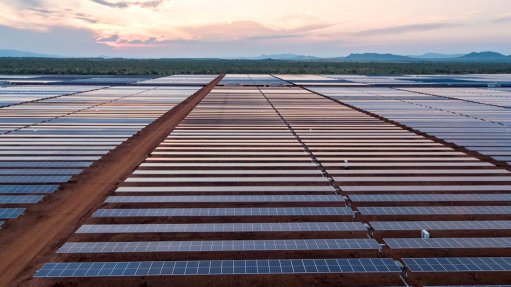On-The-Air (10/07/2015)
hEvery Friday morning, SAfm’s AMLive’s radio anchor Sakina Kamwendo speaks to Martin Creamer, publishing editor of Engineering News and Mining Weekly. Reported here is this Friday’s At the Coalface transcript:
Kamwendo: The treatment of polluted water from the abandoned Grootvlei gold mine in Springs could provide work for 7 000 people.
Creamer: This is the place of the Aurora debacle, this is one of their assets. Every time I go there and I speak to the miners they say that there is still a lot of gold down there but they can’t get to it because of the water. Of course, that water becomes acid mine drainage (AMD). But, if you go into the history of that place, you will see that even in the mid-90s there was a very good plan on that AMD. The plan was such that it would pay for itself to purify that water. For some reason or other, the Department of Water Affairs, at that stage, turned this plan down, which is a pity because it would have been a model for a lot of our mines, to which it could have been migrated. It had to be done there because that AMD caused a lot of problems in the Blesbokspruit, which is a Ramsar site, and it was killing the fish there, because they were not treating the water properly. They went in in the mid-90s and one of the researchers that is still around that can tell the story is Dr (RE) Robbie Robinson, who tells it very well. He indicates to you that although the AMD is not a good thing, there is value in that and you have got to mine the AMD, you have got to mine the metals and minerals in there, where you can get the red oxide, cobalt, nickel and uranium. Those are saleable products so you need to get a revenue stream that pays for this. At the end of it all, you get water that is already partially fertilised. He has also got a way of detoxifying slimes dams, so that you then have drip irrigation on the slimes dams and you can grow so many products. His plan was to give work to 7 000 people in the squatter camp across the way. We know that it is just devastation there. We see hostels condemned, hostel workers having to be bailed out, 250 families having to be supported by the province and also the city council. It could be so different in my view and it could also have set an example for other mines. We can see the legacy around here, why are we not thinking of what we can do with these slimes dams. Why can’t we detoxify them, as Dr RE Robinson says is very possible, and then use them for agriculture? We see there are some fantastic crops that give fantastic returns. There are many opportunities with maize and grain sorghum and about 30 crops that you can use that also provide jobs. The j-word – jobs – is huge worldwide at the moment.
Kamwendo: A billion rand is being raised in support of South Africa’s new black-industrialist vision.
Creamer: In this case it is Sphere Holdings, but we know that the government itself has R1-billion and it wants start-ups. The Department of Trade and Industry is very keen on a new era of BEE where there is more control and less just being a passenger in the whole thing. They are putting in R1-billion for start-ups, but some of the people are saying that they don't want to be start-ups. They want to actually come into existing companies as majority shareholders or leading shareholders. One of these that has a very good track record is Sphere Holdings, which is black-owned, black-controlled, black-managed. They have just come out of a private equity close out where they put a 30% addition on R300-million they raised. They raised the capital, turned it to positive account and had a more than a 30% return. Of course, their investors and institutions where very happy. They are saying now that they want to be strategic activists inside this industrialist area, particularly doing quite well in the energy and transport space with the goods and services that go into those. They have been investing in companies and already have R1.5-billion portfolio. Now they want to go much bigger so they are raising another R1-billion so that they can start becoming leading investors and have business growth influence, but also transformative growth being black controlled and make sure these companies get deeply involved in the industrial side, where we haven’t seen the correct black economic empowerment.
Kamwendo: The Botswana government this week invited tenders for the building of a solar power plant at its huge Jwaneng diamond mine.
Creamer: We know that Botswana has got so much sun and we wonder why they haven’t done this before. We heard at their last conference the Minister of Energy saying they see that renewable energy has reached a stage where it is becoming affordable, so they want to climb in, because they have got the fantastic advantage of the sun. We see them going into the most important diamond mine Jwaneng, which is the big revenue producer for diamonds overall in Botswana. Starting there with a moderately sized 100 MW power plant but a scalable one. You can see they want this to be the start of moving forward. Also, because of the north west of Botswana needing power, we know a copper mine is being resuscitated there after it had gone into liquidation and also now needs power and that will feed off this solar power that is going to be produced in Botswana, where there have been quite a few power issues. We know that they expanded their Marapula not very successfully and it is now beginning to chug along, but the government has set itself a cap and saying they won’t go beyond 1 200 MW as the government, because they have got their Eskom equivalent there as the Botswana Power Corporation. Once they hit that 1 200 MW they will be out of the business and allow private sector to come in. That is their plan at the moment. In a mixture we also see them increasing their diesel input and gas, there is a tender out for open-cycle gas-turbines. They are planning to make sure that they have got enough power in Botswana.
Kamwendo: Thanks very much. Martin Creamer is publishing editor of Engineering News and Mining Weekly, he’ll be back with us at the same time next week.
Comments
Press Office
Announcements
What's On
Subscribe to improve your user experience...
Option 1 (equivalent of R125 a month):
Receive a weekly copy of Creamer Media's Engineering News & Mining Weekly magazine
(print copy for those in South Africa and e-magazine for those outside of South Africa)
Receive daily email newsletters
Access to full search results
Access archive of magazine back copies
Access to Projects in Progress
Access to ONE Research Report of your choice in PDF format
Option 2 (equivalent of R375 a month):
All benefits from Option 1
PLUS
Access to Creamer Media's Research Channel Africa for ALL Research Reports, in PDF format, on various industrial and mining sectors
including Electricity; Water; Energy Transition; Hydrogen; Roads, Rail and Ports; Coal; Gold; Platinum; Battery Metals; etc.
Already a subscriber?
Forgotten your password?
Receive weekly copy of Creamer Media's Engineering News & Mining Weekly magazine (print copy for those in South Africa and e-magazine for those outside of South Africa)
➕
Recieve daily email newsletters
➕
Access to full search results
➕
Access archive of magazine back copies
➕
Access to Projects in Progress
➕
Access to ONE Research Report of your choice in PDF format
RESEARCH CHANNEL AFRICA
R4500 (equivalent of R375 a month)
SUBSCRIBEAll benefits from Option 1
➕
Access to Creamer Media's Research Channel Africa for ALL Research Reports on various industrial and mining sectors, in PDF format, including on:
Electricity
➕
Water
➕
Energy Transition
➕
Hydrogen
➕
Roads, Rail and Ports
➕
Coal
➕
Gold
➕
Platinum
➕
Battery Metals
➕
etc.
Receive all benefits from Option 1 or Option 2 delivered to numerous people at your company
➕
Multiple User names and Passwords for simultaneous log-ins
➕
Intranet integration access to all in your organisation




















